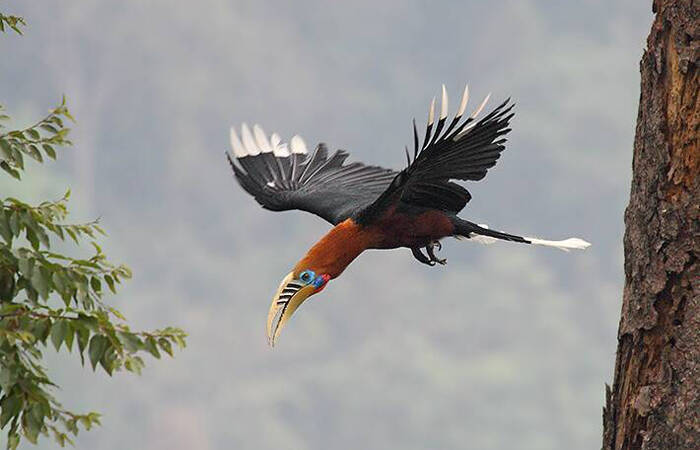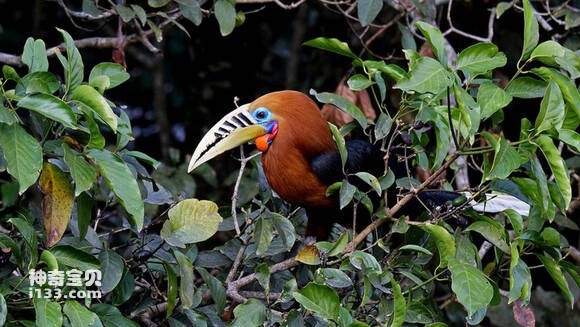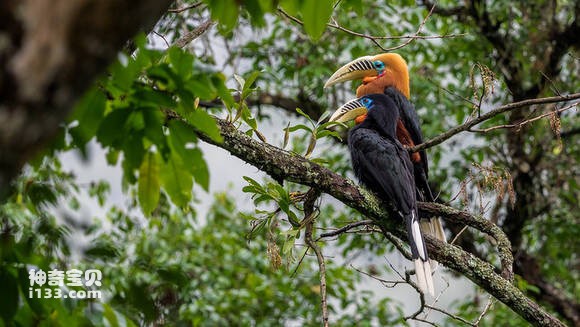Aceros nipalensis
IUCN
LCBasic Information
Scientific classification
- name:Aceros nipalensis
- Scientific Name:Rufous-necked Hornbill,Aceros nipalensis,rufous-necked hornbill
- Outline:Climbing birds
- Family:R.hornbill R.bicolor R.hornbill
Vital signs
- length:112-122cm
- Weight:2-3kg
- lifetime:30-50years
Feature
The mouth is huge and curved downwards, without a helmet
Distribution and Habitat
It mainly inhabits evergreen broad-leaved forests in low mountains and foothill plains below 1,500 meters above sea level.
Appearance
The male bird has a hair-like crest on its head. The entire head, including the crest, neck and breast, is orange-brown, gradually turning to maroon on the abdomen and the rest of the underparts. The back and wings are black with green luster, and the tips of the primary flight feathers are white. The base half of the tail is black and the end half is white. The upper mouth is yellowish white, with about 5 horizontal black carvings on both sides near the base. The lower mouth is olive at the base and milky white at the end. The exposed skin around the eyes is bright blue, and the skin at the base of the mouth is blue-purple, with a large flesh-colored spot behind it. . The exposed part of the throat is bright red, and the base of the throat is cyanotic blue.
The head, neck and underparts of the female bird are black, the exposed skin on the face is light blue, and the exposed skin at the base of the bill is dark blue. The beak is smaller than that of the male bird, and there are few
Details
Rufous-necked hornbill is a large bird with no subspecies.

Rufous-necked hornbill nests in tree holes. They often move in pairs or small groups of more than 10. They mainly feed on fleshy wild fruits such as banyan fruit.

The brown-necked hornbill is a resident bird. Both males and females make a soft whistle, Kup, which is not as deep as the double-horned hornbill.

The breeding season of the brown-necked hornbill is from April to June. It usually nests in natural tree holes in evergreen broad-leaved forests. Each nest lays 1 or 2 eggs, the egg shell is white, and the size is 54~68 mm × 40~47 mm.

The female bird incubates the eggs. When incubating the eggs, the female bird stays in the hole and piles a mixture of her own feces, seeds and sawdust at the entrance of the hole. The male bird also seals the hole with soil and fruit residues from the outside, leaving only a small hole for the female bird to stick out the tip of her beak to receive feeding from the male bird. The female bird is imprisoned in the cave to lay eggs, incubate eggs, raise chicks and molt, and only breaks out of the hole when the chicks are about to fly.

According to the analysis records of BirdLife International in 2001, the global population of the brown-necked hornbill is about 2,500~9,999, and the number of adult birds is about 1,667~6,666.
Listed in the IUCN Red List of Threatened Species: Vulnerable (VU), assessed in 2012.
Listed in the National List of Key Protected Wildlife: National Second Class Protected Animal (effective December 10, 1988). (Note: Hornbill family, all species)
Listed in the first class of the National List of Key Protected Wildlife in China.
Protect wild animals and stop eating game.
Maintaining ecological balance is everyone's responsibility!








